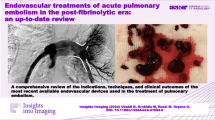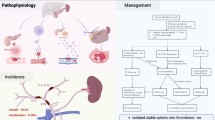Abstract
Objectives
The aim of the present study was to evaluate weather early supervised exercise improves recanalization of acute deep vein thrombosis (DVT) and reduces symptoms.
Patients and methods
From September 2001 to March 2004, of 381 patients, 72 eligible patients were included and with a mean age 54 ± 14 years, 39 (52%) men with deep vein thrombosis (DVT) proven with phlebography were randomized to: an exercise group (n = 36) receiving routine anticoagulation, class II compression stockings and additionally supervised exercise and a control group (n = 36) receiving the same therapy but no exercise. Patients were followed-up during six months. Phlebography was scored initially and at six-months.
Results
There were at inclusion no differences between the two groups regarding age, body weight, body mass index (BMI), calf circumference of the affected leg, and overall quality of life estimated by visual analog scale (VAS)-scale. In both groups there were significant reductions regarding calf circumference in the affected leg compared to the inclusion time, both at one-month (P = 0.0012) and six month (P = 0.0002) follow-up. The degree of recanalization of the affected venous segments was high and did not differ between groups. There were no recurrent DVT or pulmonary emboli or other treatment complications in any individual during the six-month follow-up period.
Conclusions
Early exercise did not acutely exacerbate the risk of complications in patients with DVT. No benefits of early exercise were seen regarding the degree of recanalization of the thrombi, or faster resolution of pain or swelling. Nevertheless, our study shows that early exercise/ambulation is safe in combination with anticoagulation and compression stockings for the majority of patients with DVT.
Similar content being viewed by others
References
Nordström M, Lindblad B, Bergqvist D, Kjellström T (1992) A prospective study of the incidence of deep-vein thrombosis within a defined urban population. J Intern Med 232:155–160
Anderson FA, Wheeler HB, Goldberg RJ, Hosmer DW, Patwardahn NA, Jovanivic B, Forcier A, Dalen JE (1991) A population-based perspective of the hospital incidence and case-fatality rates of the deep vein thrombosis and pulmonary embolism. The Worcester DVT Study. Arch Int Med 151:933–938
Arcelus JI, Caprini JA, Monreal M, Suarez C, Gonzalez-Fajardo J (2003) The management and outcome of acute venous thromboembolism: a prospective registry including 4011 patients. J Vasc Surg 38:916–922
Schellong SM, Schwarz T, Kropp J, Prescher Y, Beuthien-Baumann B, Daniel WG (1999) Bed rest in deep vein thrombosis and the incidence of scintigraphic pulmonary embolism. Thromb Heamost 82:127–129
Manganaro A, Buda D, Calabro D, Tati L, Consolo F (2000) Physical treatment of deep venous thrombosis: bed rest or mobilization? Minerva Cardioangiol 48(Suppl 1):53–56
Partsch H, Blattler W (2000) Compression and walking versus bed rest in the treatment of proximal deep venous thrombosis with low molecular weight heparin. J Vasc Surg 32:861–869
Aschwanden M, Labs KH, Engel H, Schwob A, Jeanneret C, Mueller-Brand J, Jaeger KA (2001) Acute deep vein thrombosis: early mobilization does not increase the frequency of pulmonary embolism. Thromb Haemost 85:42–46
Blattler W, Partsch H (2003) Leg compression and ambulation is better than bed rest for the treatment of acute deep venous thrombosis. Int Angiol 22:393–400
Schulman S (1985) Studies on the medical treatment of deep vein thrombosis. Acta Med Scand 704(Suppl):1–68
Egermayer P (2001) The effects of heparin and oral anticoagulants on thrombus propagation and prevention of the postphlebitic syndrome: a critical review of the literature. Prog Cardiovasc Dis 44:69–80
Trujillo-Antos AJ, Martos-Perez F, Perea-Milla E (2004) Bed rest or early mobilization as treatment of deep vein thrombosis: a systematic review and meta-analysis. Med Clin 122:641–647
Killewich LA, Macko RF, Cox K, Franklin DR, Benjamin ME, Lilly MP, Flinn WR (1997) Regression of proximal deep venous thrombosis is associated with fibrinolytic enhancement. J Vasc Surg 26:861–868
Bodary PF, Yasuda N, Watson DD, Brown AS, Davis M, Pate RR (2003) Effects of short-term exercise training on plasminogen activator inhibitor PAI-1. Med Sci Sport Exerc 35:1853–1858
Killewich LA, Macko RF, Montgomery PS, Wiley LA, Gardner AW (2004) Exercise training enhances endogenous fibrinolysis in peripheral arterial disease. J Vasc Surg 40:741–745
Gardner AW, Killewich LA (2002) Association between physical activity and endogenous fibrinolysis in peripheral arterial disease: a cross-sectional study. Angiology 53:367–374
Manganaro A, Buda D, Consolo F (2000) Compression therapy in deep venous thrombosis. Minerva Cardioangiol 48(Suppl 1):57–60
Gertszten PC (1999) Outcomes research: a review. Neurosurgery 43:919–920
Björgell O, Nilsson PE, Svensson PJ, Bergqvist D (1999) A new scoring system for the detailed description of the distribution and the thrombotic burden in deep leg vein thrombosis. Angiology 50:179–187
Björgell O, Nilsson PE, Jarenros H, Nylander G (2000) Scoring of extensive deep leg vein thrombosis displayed as wide-spread non-filling of contrast on phlebography. A comparison with color doppler ultrasonography. Acta Radiol 41:605–611
Harisson L, McGinnis J, Crowther M, Ginsberg J, Hirsch J (1998) Assessment of outpatient treatment of deep-vein thrombosis with low-molecular-weright heparin. Arch Intern Med 158:2001–2003
Lapidus L, Borretzen J, Fahlen M, Thomsen HG, Hasselblom S, Larson L, Nordström H, Stigendal L, Waller L (2002) Home treatment of deep vein thrombosis. An out-patient treatment model with once-daily injection of low-molecular-weight heparin (tinzaparin) in 555 patients. Pathophysiol Haemost Thromb 32:59–66
Monreal M (1999) Which DVT patients could be considered the best candidates for home therapy? Thromb Haemost 81:996–997
Labas P, Ohradka B, Cambal M (2001) Could deep vein thrombosis be safely treated at home? Bratisl Lek Listy 102:458–461
Hull R, Raskob G, Pineo G, Rosenbloom D, Evans W, Mallory T, Änquist K, Smith F, Hughes G, Green D (1993) A comparison of subcutaneous low-molecular-weight heparin with warfarin sodium for prophylaxis against deep-vein thrombosis after hip or knee implantation. N Engl J Med 329:1370–1376
Partsch H, Kechavarz B, Kohn H, Mostbeck A (1997) The effect of mobilisation of patients during treatment of thromboembolic disorders with low-molecular-weight heparin. Int Angiol 16:189–192
Marder VJ, Soulen RL, Atichartakran V, Budzynski AZ, Parulekar S, Kim JR, Edward N, Zahavi J, Algazy KM (1977) Quantitative venographic assesment of deep vein thrombosis in the evaluation of streptokinase and heparin therapy. J Lab Clin Med 89:1018–1029
Arnesen H, Heilo A, Jakobsen E, Ly B, Skaga E (1978) A prospective study of streptokinase and heparin in the treatment of deep vein thrombosis. Acta Med Scand 203:457–463
Reporting standards in venous disease (1988) Prepared by the subcommittee on reporting standards in venous disease, ad hoc committee on reporting standards, Society for Vascular Surgery/North American Chapter, International Society for Cardiovascular Surgery. J Vasc Surg 8:172–181
Labas P, Ohradka B, Vladimir J, Cambal M (2000) The home treatment of deep vein thrombosis with low molecular weight heparin, forced mobilisation and compression. Int Angiol 19:303–307
Partsch H (2001) Therapy of deep vein thrombosis with low molecular weight heparin, leg compression and immediate ambulation. Vasa 30:195–204
Author information
Authors and Affiliations
Corresponding author
Rights and permissions
About this article
Cite this article
Isma, N., Johanssson, E., Björk, A. et al. Does supervised exercise after deep venous thrombosis improve recanalization of occluded vein segments? A randomized study. J Thromb Thrombolysis 23, 25–30 (2007). https://doi.org/10.1007/s11239-006-9010-y
Published:
Issue Date:
DOI: https://doi.org/10.1007/s11239-006-9010-y




